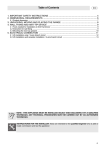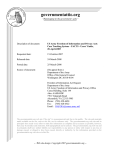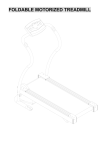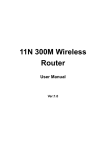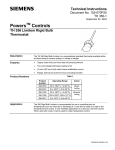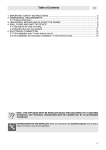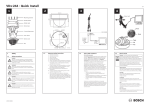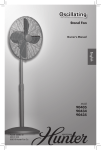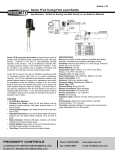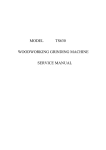Download DWYER INSTRUMENTS, INC.
Transcript
FL-1-BFM:TEMPLATE 12/4/08 10:59 AM Page 1 Bulletin FL-1-BFM Series BFM Bulk Flow Monitor Specifications - Installation and Operating Instructions 4x 3/4˝ CONDUIT KNOCKOUTS PRODUCT LABEL FOR MAIN CONTROLLER UNIT 5-9/64 [130.45] 3[76.20] TRANSFORMER 1-19/32 [40.64] 1A FUSE RED LED RELAY 6X 1/2˝ CONDUIT KNOCKOUT GREEN LED 7 [177.80] 1/2 [12.69] 3 SENSOR [76.20] TIP 1-1/2 [38.10] 3/32 [2.29] 6´ 18 AWG WIRE FLOW SENSOR SENSITIVITY ADJUSTMENT POTENTIOMETER BFM FLOW MONITOR BFM BFS Series BFM Bulk Flow Monitor provides effective monitoring for most flow/no flow conditions in pipes and chutes. It’s sensing techniques, which use a Piezo element, makes the BFM versatile for most flow/no flow applications. The BFM Control offers many unique advance features that exceed the industry standards. The BFM Central Processing Unit monitors movement of almost anything through a pipe or chute system. The BFM is ideal for sensing the presence or absence of materials in Pneumatic Conveying Systems. The BFM offers adjustable sensitivity depending on the application demand. Also, it provides easy installation and requires no maintenance. The unit has L.E.D indicators – flow (green)/ no flow (red). The BFS-1 Sensor yields many advance features. It externally mounts to the outside of the pipe or chute. It provides mounting tabs for easy installation. The Sensor is prewired with 3´ wire. Series BFM has many practical applications. You can use it to monitor Oil Spray Systems, Discharge Chutes, Distributors, Screw Conveyors, Drag Conveyors, Water Systems, Air Systems, Pneumatic Systems, Gravity Feed Systems, Slurry Systems, Chemical Processing, Food Processing and Rotary Drums. Part Number BFM-1 BFM-2 BFM-3 BFS-1 DWYER INSTRUMENTS, INC. P.O. BOX 373 • MICHIGAN CITY, INDIANA 46361, U.S.A. SPECIFICATIONS BFM Specifications Service: Solids and liquids. Power Requirement: 120VAC, 220VAC or 12VDC. Power Consumption: .1A. Temperature Limits: 120°F (48.9°C). Output: Relay: SPDT rated 4A @ 125/250VAC, 1/10 HP @ 125/250VAC, 3A @ 30VDC. TTL: 0-5 V. Serial Communications: RS-232. Electrical Connection: Screw Terminal. Conduit Connection: Knockouts (two 3/4˝ for power, three 1/2˝ for sensor and outputs). Enclosure Rating: NEMA 4. Material: Polycarbonate. Weight: 3 lbs (1.36 kg). BFS Specifications Pipe Size: 1/2˝ to 60˝ (1.27 to 152.4 cm). Enclosure Rating: NEMA 4. Electrical Connection: 3´ (0.9 m) of 18 gauge wire. Temperature Limits: 155°F (68.3°C). Materials: PVC Type 1 Grade 1 Grey. Weight: 5 oz (141.8 g). Descriptions Control Unit: NEMA 4X, Polycarbonate Housing, Weatherproof, 120VAC Control Unit: NEMA 4X, Polycarbonate Housing, Weatherproof, 220VAC Control Unit: NEMA 4X, Polycarbonate Housing, Weatherproof, 12VDC Sensor Phone: 219/879-8000 Fax: 219/872-9057 www.dwyer-inst.com e-mail: [email protected] FL-1-BFM:TEMPLATE 12/4/08 10:59 AM Page 2 BFM WIRING The BFM polycarbonate housing comes with 10 PG conduit knockouts in the housing. • A 1-Amp fuse is located next to the transformer. • High voltage inputs above 24 volt AC should be routed into the housing through the 3/4˝ (20mm) conduit hole. • All Low voltage wiring (TTL, RS232, and sensor) should be routed through the 1/2˝ (14mm) conduit hole. 3/4˝ HIGH VOLTAGE INPUT 1/2˝ LOW VOLTAGE INPUT Figure 3 Figure 1 HIGH VOLTAGE INPUTS Connect the 120VAC, 50/60 HZ, 1 Amp supply on TB2 terminals (Fig. 2): • 120VAC (Hot) supply to 117VAC terminal (or 12VDC, 240VAC per the model) • AC Common to AC COM terminal • Earth-Ground to E GND terminal. Must connect to prevent accidental electrical shock. SENSOR INPUTS Connect the low voltage Flow Sensor to the Sensor terminals TB1 (Fig. 4): • Positive RED (or White) sensor lead to the “+” Sensor terminal on TB1. • Negative BLACK sensor lead to the “-” Sensor terminal on TB1. The sensor wiring should be a minimum of 18 AWG stranded 2-conductor cable. Use 18 AWG for up to 500´ (155m) and 16 GA up to 2000' (620m). • All Sensor wire splices must be SOLID and WATER TIGHT. Figure 2 Figure 4 FL-1-BFM:TEMPLATE 12/4/08 10:59 AM Page 3 RELAY AND LOW LEVEL LOGIC WIRING SIDE VIEW FRONT VIEW See those sections later in this manual. BFM SENSOR SENSOR INSTALLATION The BFS-1 sensor is in very a rugged polymer housing with a sealed 6´ cable pigtail (Fig. 5): • Red/Black = Positive • White/Black = Negative (this is electrically connected to the metal sensor stud) NOTE: PILOT HOLES ARE DRILLED INTO FLAT SURFACE AND MOUNTED WITH PORPER HARDWARE. BFM SENSOR Figure 6 MOUNTING TO A ROUND OR NON-FLAT SURFACE: (FIG. 7) BFM SENSOR • Using strapping (such as heavy duty wire-ties) or clamps to secure the sensor housing to the pipe so the metal sensing stud makes firm contact with the surface. BLACK LEAD RED/WHITE LEAD SIDE VIEW FRONT VIEW Figure 5 MOUNTING PROCEDURES FOR SENSOR: The BFS-1 Sensor can be screwed, clamped or strapped in place and is able to detect flow through most sheet metal. • Clean the surface area where the sensor is to be installed. The surface should not have any buildup or scale but does be perfectly clean. • The sensor stud located at the bottom of the sensor housing must make solid contact with the surface of the pipe to be monitored. MOUNTING TO A FLAT SURFACE: Refer to the mounting holes located at each end of sensor housing (Fig. 6). • Mark mounting holes. • Drill pilot holes for mounting screws. • Screw sensor housing to flat surface. BFM SENSOR NOTE: STRAPS OR CLAMPS ARE USED FOR MOUNTING TO NON-FLAT SURFACE Figure 7 BFM SENSOR FL-1-BFM:TEMPLATE 12/4/08 10:59 AM Page 4 SENSOR LOCATION: TO ENHANCE SENSITIVY INSTALL THE SENSOR WHERE THE FLOW IS MOST TURBULENT OR WHERE MATERIAL IMPACTS THE PIPE WALL. THE FOLLOWING POINTS ARE IDEAL (FIG 8): • Pipe elbow • Point where material drops into spouting or chutes • Point where material drops from conveyor onto the chute BE SURE SENSOR STUD IS MAKING A GOOD TIGHT CONTACT WITH MOUNTING SURFACE. TTL LOGIC OUTPUT: The TTL Logic output is a 5VDC output. To obtain a TTL Logic Output install jumper J3 as indicated on the BFM PCB. Connect logic level output wiring to the “Out” (+5V) terminal and the Sensor “-” (0V) terminals on TB1. • NO FLOW: Red LED lights and 0VDC will be present at the “OUT” terminal. • FLOW: Green LED will light and 5VDC will be present at the “OUT” terminal. RS232 LOGIC OUTPUT: STUD SENSOR The RS232 output is an industry standard 5VDC minimum into 3K load. To obtain an RS232 logical output do not install jumper J3 as indicated on BFM PCB. • NO FLOW: Red LED lights and 0 VDC will be present at the "OUT" terminal. • FLOW: Green LED will light and 5VDC min. will be present at the "OUT" terminal. INPUT PUMP Figure 8 NOTE: For proper logic input to your computer, consult your computer manual for the correct pin configuration for RS232 or TTL. LOW LEVEL (LOGIC) OUTPUT WIRING Low level outputs available (Fig. 9): • TTL logic output • RS232 logic output RELAY OUTPUT WIRING Relay (CTR1) Contact Specifications: • 4 amp at 125 or 250 VAC • 1/10 HP at 125 or 250 VAC • 3 amp at 30 VDC Relay Output Wiring on TB2 (Fig. 10): • COM = Common contact • N/C = Normally closed • N/O = Normally open Figure 9 Figure 10 FL-1-BFM:TEMPLATE 12/4/08 10:59 AM Page 5 SOUNDING AN ALARM TO INDICATE DECREASED FLOW: Before the “controlled” equipment can be started again, the following must occur: An alarm will sound when flow drops below the preset amount (Fig. 11): • Material is flowing past the BFS-1 sensor. • The Green L.E.D. (FLOW) indicator light is lit indicating material flow. • You may have to hold down the Start button until flow reaches the preset rate. • When flow drops the relay contacts close to energize the alarm. • The power to the alarm (connected to the COM terminal) is from the motor starter circuit so the alarm can only sound when the motor is running. When the motor Stop button is pressed the alarm will silence. As long as material continues to flow past the BFS-1 sensor above the preset rate, the machine equipment supplying material will continue to run. If the rate of material flow falls below the preset level, the relay will open and the machine equipment supplying the material will stop. START SWITCH MACHING SUPPLYING MATERIAL MOTOR STARTER STOP TB2 START STARTER COIL COM N/0 NOTE: AUXILLARY SET OF NORMALLY CLUSED CONCACTS (CLOSED WHEN STARTER IS ENERGIZED). 117VAC ALARM TB2 N/C COM AC COM N/0 M/C Figure 11 SHUTTING DOWN DECREASES: EQUIPMENT STARTER CIRCUIT WITH BFM SHUTDOWN WHEN FLOW Figure 13 Equipment shut down mode is required if the flow rate drops below the preset level. The relay is often wired to stop the equipment that is supplying the material (Fig. 12 and 13). STOP START STARTER COIL NORMAL STARTER CIRCUIT Figure 12 FL-1-BFM:TEMPLATE 12/4/08 10:59 AM Page 6 SENSITIVITY RANGE ADJUSTMENT AND CALIBRATION The BFM has (3) three sensitivity range inputs. Select the range to get the desired sensitivity for the application. WARNING: TO AVOID ELECTRICAL SHOCK DISCONNECT AC SUPPLY VOLTAGE BEFORE ADDING OR REMOVING JUMPERS ON TB1. • Minimum (low) range: Install jumper J2 (only) • Medium range: No jumpers installed (as shipped from factory) • Maximum (high) range: Install jumper J1 (only) ADJUSTING THE SENSITIVITY RANGE: NOTE: The sensitivity range is factory preset to the Medium range (no jumpers installed). Verify that the supply voltage and the flow sensor are wired and installed correctly prior to testing (Fig. 14). After selecting proper sensitivity range, proceed to the next calibration section. 1. With no material flowing, turn the Sensitivity adjustment to full clockwise position: • RED LED will turn on. 2. Start the material flowing at the full rate you wish to monitor: • If the GREEN LED turns on, then turn the Sensitivity adjustment fully counterclockwise. If that causes the RED LED to turn on then the correct sensitivity range is selected. If that does not cause the RED LED to turn on (Green stays lit) then install jumper J2 (Minimum range) and repeat the test beginning with step #1. • If the GREEN LED does not turn on when material is flowing, then install jumper J2 (Maximum range) and repeat the test beginning with step #1. Figure 14 FL-1-BFM:TEMPLATE 12/4/08 10:59 AM Page 7 BFM CALIBRATION: Perform sensitivity range jumper selection before performing calibration. 1. Stop all material from flowing. 2. Turn the Sensitivity adjustment fully clockwise. 3. Start material flowing at the minimum full flow rate desired • GREEN L.E.D. will light to indicate FLOW. 4. Turn the Sensitivity adjustment counter clockwise until the RED LED lights to indicate NO FLOW. 5. Turn the Sensitivity adjustment clockwise very slowly until GREEN LED lights to indicate FLOW. 6. Calibration is now complete. FINAL SYSTEM CHECK: • Stop or reduce flow of material and the GREEN LED (FLOW) will go out and the RED LED (NO FLOW) will light. MAINTENANCE Upon final installation of the Series BFM Bulk Flow Monitor, no routine maintenance is required. A periodic check of system calibration is recommended. The Series BFM is not field serviceable and should be returned if repair is needed (field repair should not be attempted and may void warranty). Be sure to include a brief description of the problem plus any relevant application notes. Contact customer service to receive a return goods authorization number before shipping. FL-1-BFM:TEMPLATE 12/4/08 10:59 AM Page 8 ©Copyright 2008 Dwyer Instruments, Inc. Printed in U.S.A. 12/08 DWYER INSTRUMENTS, INC. P.O. BOX 373 • MICHIGAN CITY, INDIANA 46361, U.S.A. Phone: 219/879-8000 Fax: 219/872-9057 FR#R2-443673-00 www.dwyer-inst.com e-mail: [email protected]








